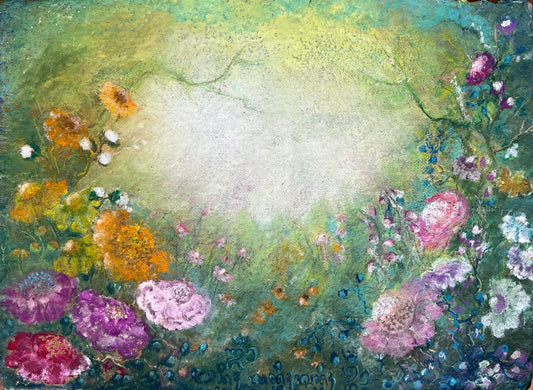Niluh Swati Bio
Niluh Swati is a Balinese artist whose work is deeply rooted in the traditions of Bali Island. Born in a village where art is both a practice and a way of life, she grew up surrounded by painters, dancers, and master woodcarvers. She developed a profound appreciation for traditional craftsmanship and the power of storytelling through art. Her fascination with Balinese script (Aksara Bali) began early, sparked by winning a writing competition in elementary school, an experience that would shape her artistic journey for years to come.
For Niluh, art is about preservation and devotion. In Balinese philosophy, Bhaktimarga teaches that creating fine artwork is a sacred offering, a way to honor the legacy of her ancestors, express the soul, and connect with something beyond the visible world. This belief is woven into every piece she paints. Her art is a creative expression that carries meaning beyond mere purpose.
In 2008, Niluh moved to Singapore to join Singapore Airlines, embarking on a career that took her across five continents. Traveling became a wellspring of inspiration, exposing her to diverse cultures, colours, and artistic expressions. Despite this global exposure, she eventually found her true sanctuary in painting, a form of therapy and a way to reconnect with herself.
In 2019, Niluh relocated to Germany, adapting to a new culture while remaining steadfast in the essence of her Balinese heritage. No matter where she is, painting remains her constant companion, a source of freedom and balance.

Niluh’s work spans intricate, abstract, and floral pieces created with oil, acrylic, and mixed media, all guided purely by intuition. It exists in Balinese prayers and intricate expressions on canvas. Her abstract elements flow freely, yet when incorporating Balinese script, she adheres to its sacred structure and linguistic precision. The placement of letters and diacritical marks in Aksara Bali is integral to their meaning and pronunciation, and Niluh respects these rules. This structured approach to the script, combined with the fluidity of her abstract work, creates a striking blend where heritage meets modern creativity.
Describing her artistic philosophy, Niluh believes that art is a balance of natural talent, tradition, and continuous learning. Her studies in Healing with the Arts at the University of Florida, as well as in Arts, Heritage Management, and Curatorship at Bocconi University in Italy, have deepened her understanding of how art can transform the viewer and foster well-being.
Central to her work is the preservation of the ancient Balinese script, an art form more than 1,000 years old, which Niluh strives to introduce to a wider audience. Through her paintings, she ensures the script’s cultural significance endures in contemporary art. Her mission is to create work that transcends space, transforming it with a sense of presence, an oasis away from the chaos of everyday life.
Aksara Bali, the ancient Balinese script, embodies the island’s spiritual depth and cultural heritage. Once used widely in sacred texts and temple carvings, it is now exceptionally rare and understood by only a limited number of people, even within Bali. Beyond the island, it remains largely unfamiliar. Every artwork that incorporates the script becomes both a creative expression and a preservation of intangible cultural heritage, bridging tradition and contemporary art with aesthetic and historical value.

Niluh’s work is infused with deeper layers of meaning, blending spiritual significance with Balinese traditions. Her art incorporates blessings through mantras written in Aksara Bali, connecting each piece to sacred energy. In Balinese culture, the Pasupati ritual is performed to bless objects, transforming them into spiritually empowered tools. Her painting brushes undergo this ceremony, ensuring that every stroke carries intention, protection, and ancestral wisdom. Each artwork becomes a vessel of Taksu, a spiritual charisma that bridges heritage and contemporary creativity. Collecting her art means welcoming a piece of Bali’s blessing into your space and helping to keep Balinese heritage alive.
Niluh’s art is meant to be both seen and felt. It exists in the quiet moments, the glide of a brush, the scent of mountain air, the sound of laughter. It’s in deep conversations, the freedom of travel, and the boundless joy of nature.
Her work has found homes around the world, collected by those who seek art with depth, history, and soul. She is a member of the Frankfurter Kunstverein, one of Germany’s oldest and most prestigious municipal art associations, and operates a registered art business in Germany, reinforcing her commitment to the professional art market. She is also an official member of the Professional Association of Visual Artists Frankfurt am Main (BBK Frankfurt). BBK Frankfurt is part of the Federal Association of Visual Artists (BBK), which represents the interests of professional artists throughout Germany.
Each of Niluh’s paintings carries a secret: the meaning of the Aksara inscribed within them. AI cannot replicate this, nor can mass production diminish its soul. Upon acquisition, collectors receive an authentication card detailing the Sanskrit mantras, translated into both Sanskrit and English, revealing layers of wisdom beyond the visible brushstrokes.
When you experience Niluh’s work, she hopes it speaks to you, offering a deeper connection to the past, grounding you in the present, and preserving a path toward the future.
“Hear the heart. Adore the art.”
